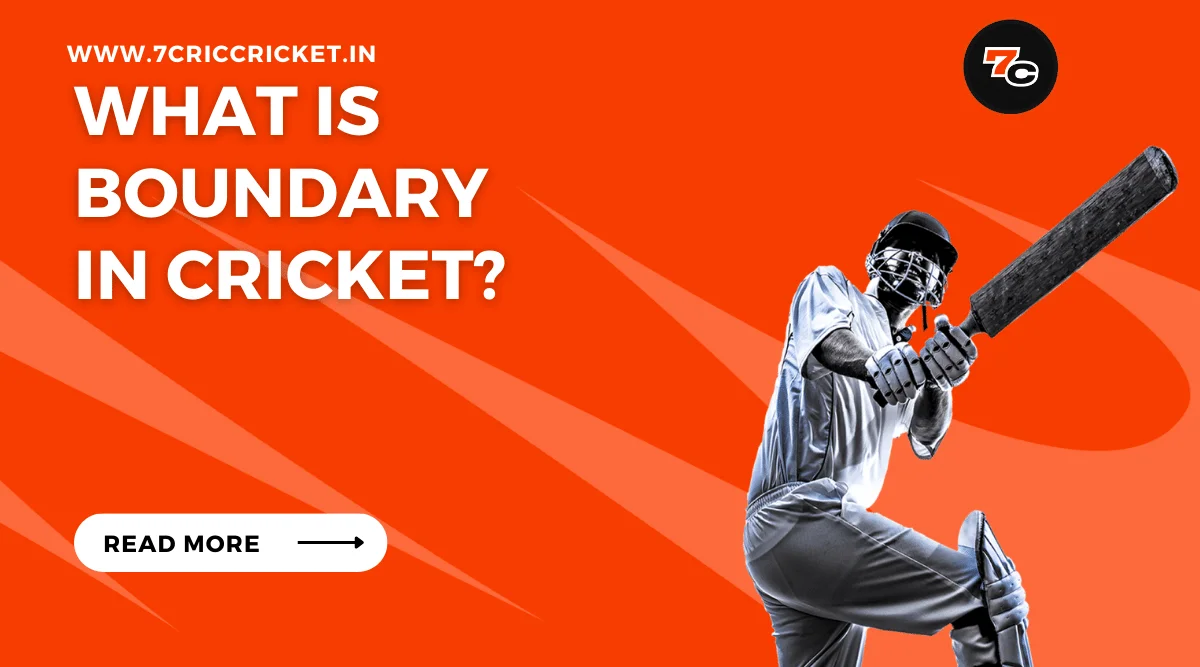What Is Boundary in Cricket?
Cricket, a sport steeped in tradition and strategy, employs a scoring system that includes boundaries.
Boundaries in cricket refer to the act of the ball crossing the designated lines on the field, resulting in runs being awarded to the batting team.
Get up to ₹20,000 Bonus Every Week!
Get up to ₹20,000 Bonus Every Week!
- Easy Sign-Up and Deposits
- Fast deposits with UPI
- 300% Welcome Bonus up to ₹10,000
In this article, we will explore the definition of boundaries, the various types, how they are scored, the rules and regulations governing them, and their significance in the game.
Gain a comprehensive understanding of this essential aspect of cricket and enhance your appreciation for the sport.
Key Takeaways
Hide- Boundaries in cricket refer to when the ball reaches or crosses the marked perimeter of the field.
- Fielding plays a crucial role in boundary protection, and a strong fielding unit can prevent boundaries by covering the ground quickly and executing accurate throws.
- Batsmen look for scoring opportunities in the gaps between fielders to maximize boundary hits.
- Different types of boundaries, such as fours and sixes, have specific run values and enhance the excitement of the game.
The Definition of Boundary
A boundary in cricket is defined as the act of hitting the ball and scoring runs by making it reach or cross the marked perimeter of the field.
It is a crucial element of the game, as it allows batsmen to accumulate runs quickly and puts pressure on the fielding team.
The importance of fielding in boundary protection cannot be overstated. A strong fielding unit can prevent boundaries by swiftly covering the ground, intercepting the ball, and executing accurate throws.
On the other hand, a weak fielding team can concede easy boundaries, giving the batting side an advantage.
Batsmen also play a pivotal role in maximizing boundary hits. They employ various strategies to achieve this feat.
One such strategy is to look for scoring opportunities in the gaps between fielders. By placing the ball precisely in these areas, batsmen increase their chances of hitting a boundary.
Additionally, they can employ power hitting techniques, such as lofted shots or sweeps, to clear the field and send the ball over the boundary rope.
Understanding the definition of a boundary and the importance of fielding in boundary protection sets the stage for exploring the different types of boundaries in cricket.
Types of Boundaries in Cricket
The various types of boundaries in cricket enhance the excitement of the game and provide batsmen with different scoring opportunities within the marked perimeter of the field.
Here are three types of boundary techniques used in cricket:
- Four: A four is the most common boundary in cricket. It is scored when the batsman hits the ball and it crosses the boundary rope on the ground without bouncing. This can happen through a powerful drive, a well-timed cut shot, or a delicate flick.
- Six: A six is the most thrilling boundary in cricket. It occurs when the batsman hits the ball over the boundary rope without it touching the ground. This requires immense power and precision and is often achieved through lofted shots or big hits.
- Overthrows: Overthrows are an unconventional way of scoring boundaries. They occur when the fielders fail to control the ball and it goes past the boundary rope, allowing the batsmen to collect extra runs. Overthrows can result from miscommunication between fielders or inaccurate throws.
Throughout cricket history, there have been numerous famous boundary shots that have left fans awestruck.
From the iconic six by Carlos Brathwaite in the 2016 T20 World Cup final to the elegant cover drive by Sachin Tendulkar, these shots showcase the skill and innovation of batsmen.
Boundaries play a crucial role in determining the outcome of a cricket match, providing opportunities for batsmen to accumulate runs and entertain the audience with their stroke play.
How Boundaries Are Scored
Boundaries in cricket are scored when the batsman successfully hits the ball beyond the boundary rope, resulting in runs being added to their team’s total.
There are several scoring techniques and fielding strategies employed to prevent boundaries and minimize the opposition’s score.
Scoring boundaries is an essential part of a batsman’s game plan. The table below outlines the different types of boundaries and their corresponding run value:
| Boundary Type | Runs |
|---|---|
| Four | 4 |
| Six | 6 |
| Overthrow Four | 4 |
A four is scored when the ball touches or crosses the boundary rope after bouncing within the field of play. On the other hand, a six is awarded when the ball clears the boundary rope on the full, without bouncing.
In some cases, fielding errors can lead to overthrows, resulting in an extra four runs being awarded to the batting team.
Fielding strategies are crucial in preventing boundaries. Teams strategically position fielders at the boundary to save runs.
This involves placing fielders in key positions, such as deep mid-wicket, long-on, or third man, depending on the batsman’s strengths and the bowler’s line and length.
Rules and Regulations for Boundaries
Rules and regulations govern the scoring of boundaries in cricket. Understanding these rules is essential for both players and spectators to fully appreciate the game. Here are three key aspects of the rules and regulations for boundaries:
- Fielding positions for boundary protection: In cricket, teams strategically position fielders to prevent the ball from crossing the boundary and scoring runs. Fielders are typically placed near the boundary line to catch or field the ball, aiming to restrict the batsman’s ability to score boundaries.
- Impact of boundary dimensions on game strategy: The dimensions of the boundary can significantly impact the game strategy. A smaller boundary allows batsmen to target specific areas, increasing the likelihood of scoring boundaries. On the other hand, a larger boundary requires batsmen to exert more power and precision to clear the fielders and score boundaries.
- Rules for scoring boundaries: According to the rules, a boundary is scored when the ball is hit by the batsman and crosses the boundary line on the full. The four main types of boundaries are four runs for hitting the ball along the ground and crossing the boundary, six runs for hitting the ball over the boundary on the full, five runs for hitting the ball and it directly touching a boundary marker, and six runs for hitting the ball and it directly touching the top of the boundary fence.
Understanding these rules and regulations for boundaries allows cricket enthusiasts to grasp the nuances of the game and appreciate the skill involved in scoring runs.
The Significance of Boundaries in Cricket
Boundaries play a crucial role in shaping the dynamics of a cricket match. They are not just a means to add runs to the scoreboard; they also have a significant impact on the outcome of the game.
Teams strategize to maximize boundary scoring as it provides them with an opportunity to score more runs in a single delivery, putting pressure on the opposition.
To understand the significance of boundaries in cricket, let’s take a look at the impact of boundary count on the outcome of a match.
The table below showcases the boundary count for two teams in a hypothetical cricket match:
| Team A | Team B |
|---|---|
| 10 | 5 |
In this scenario, Team A has hit 10 boundaries, while Team B has hit only 5. It is evident that Team A has been more successful in finding the boundary ropes, indicating their ability to score more runs and put pressure on the opposition.
This higher boundary count can translate into a higher overall score, making it more challenging for Team B to chase or defend.
Strategies to maximize boundary scoring in cricket include aggressive batting, targeting the gaps in the field, and using innovative shots.
Batsmen often aim to clear the boundary ropes to earn six runs, providing a significant boost to their team’s total.
Up to 75% Reload Bonus on Aviator
Up to 75% Reload Bonus on Aviator
- Fastest Indian Rupees Withdrawals
- The Biggest Bonuses in India
- 300% Welcome Bonus up to ₹10,000
Drawing the Line: Unraveling the Intricacies of Cricket’s Boundary Rule in the Final Over
In conclusion, boundaries play a crucial role in cricket, adding excitement and value to the game. They are defined as the lines that mark the perimeter of the playing field, and there are various types of boundaries that players can score.
Boundaries not only contribute to the overall score but also showcase the skill and technique of the batsmen. Adhering to specific rules and regulations, boundaries are an integral aspect of cricket that captivates both players and spectators alike.
Frequently Asked Questions (FAQs)
What Is the Minimum Distance a Fielder Must Be From the Boundary to Save a Boundary in Cricket?
The minimum distance a fielder must be from the boundary to save a boundary in cricket depends on various factors such as the height of the boundary rope. This ensures fair play and prevents fielders from gaining an unfair advantage.
Is There Any Specific Rule Regarding the Height at Which the Ball Must Cross the Boundary to Be Considered a Boundary?
The height at which the ball crosses the boundary does not affect the number of runs scored in cricket. If the ball bounces before crossing the boundary rope but still goes over it, it is still considered a boundary.
Can a Boundary Be Scored if the Ball Touches the Boundary Rope but Is Caught by a Fielder Before It Touches the Ground?
No, a boundary cannot be scored if the ball touches the boundary rope but is caught by a fielder before it touches the ground. The number of runs scored for a boundary is determined by the ball crossing the boundary rope without being caught.
Are There Any Scenarios Where a Boundary Can Be Awarded Without the Ball Touching the Boundary Rope?
In cricket, there are scenarios where a boundary can be awarded without the ball touching the boundary rope. This can occur when the ball is hit over the boundary without touching the ground, resulting in a six. Fielding techniques are utilized to prevent boundaries in cricket.
How Is the Number of Runs Scored for a Boundary Determined in Cricket?
Scoring boundaries in cricket involves various ways to score runs without hitting the boundary rope. The role of umpires is crucial in determining whether a shot is a boundary or not, as they make the final call on the matter.








